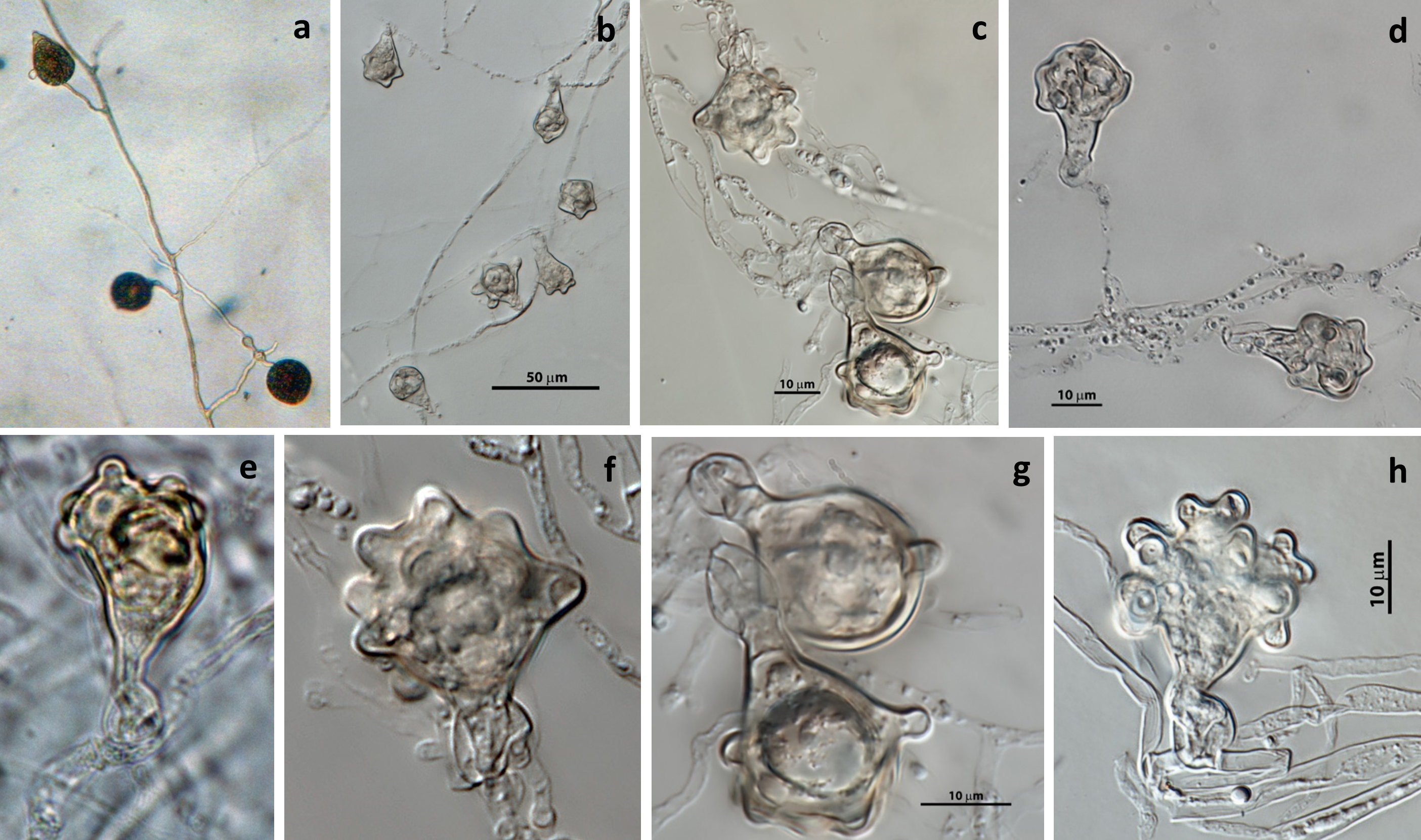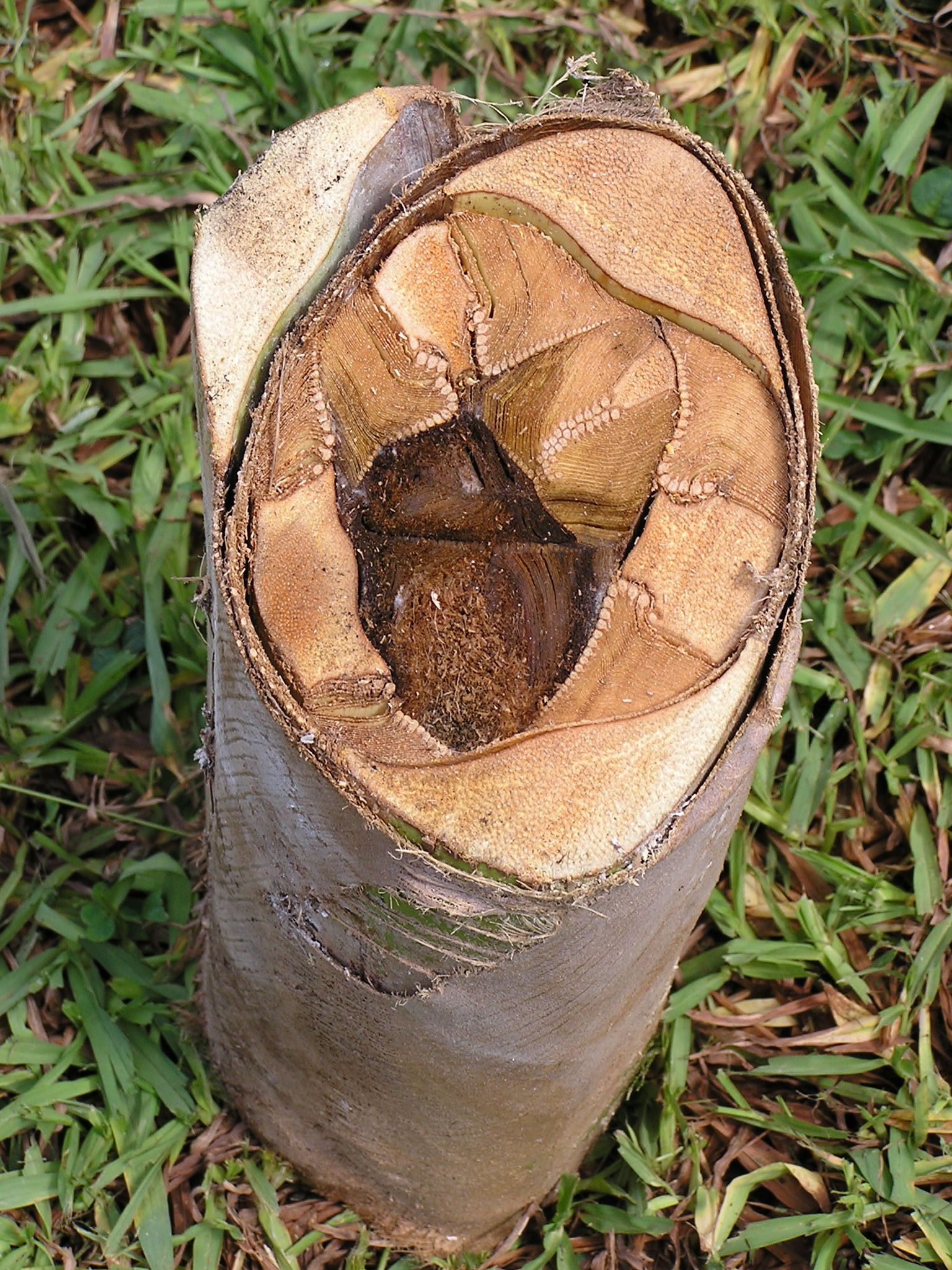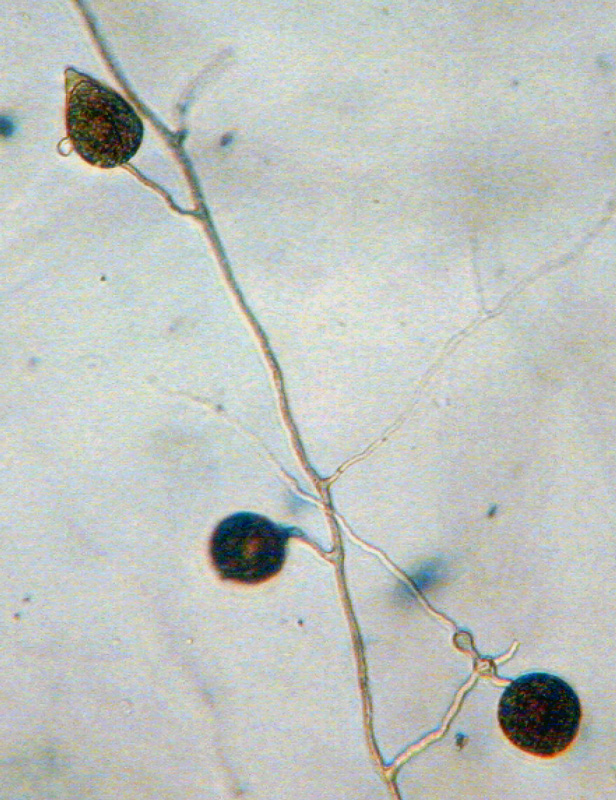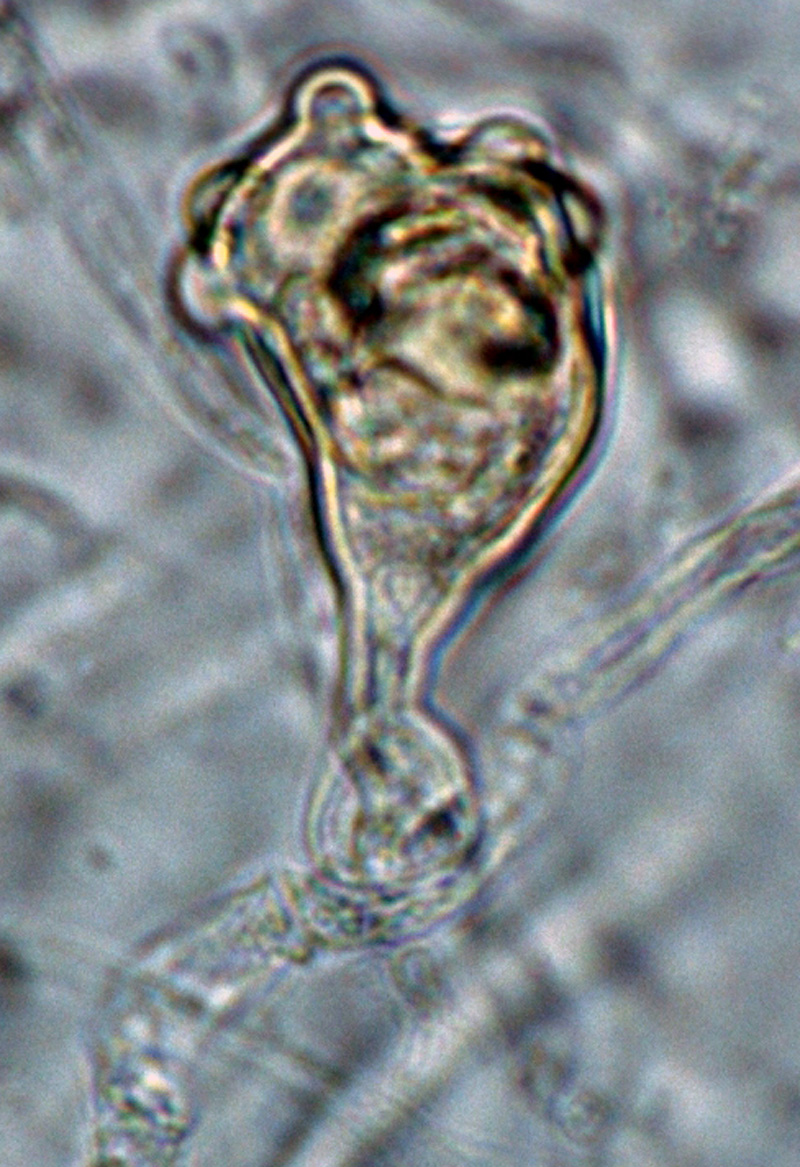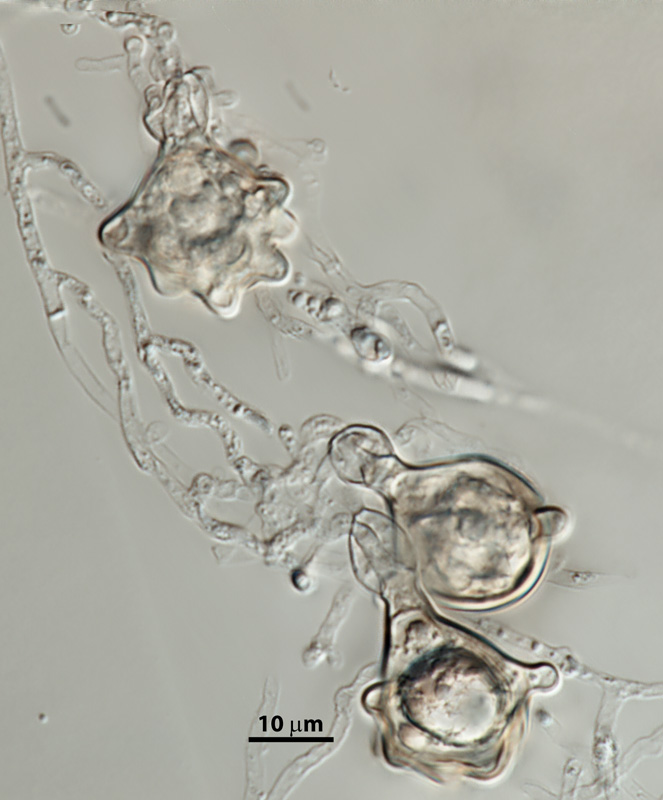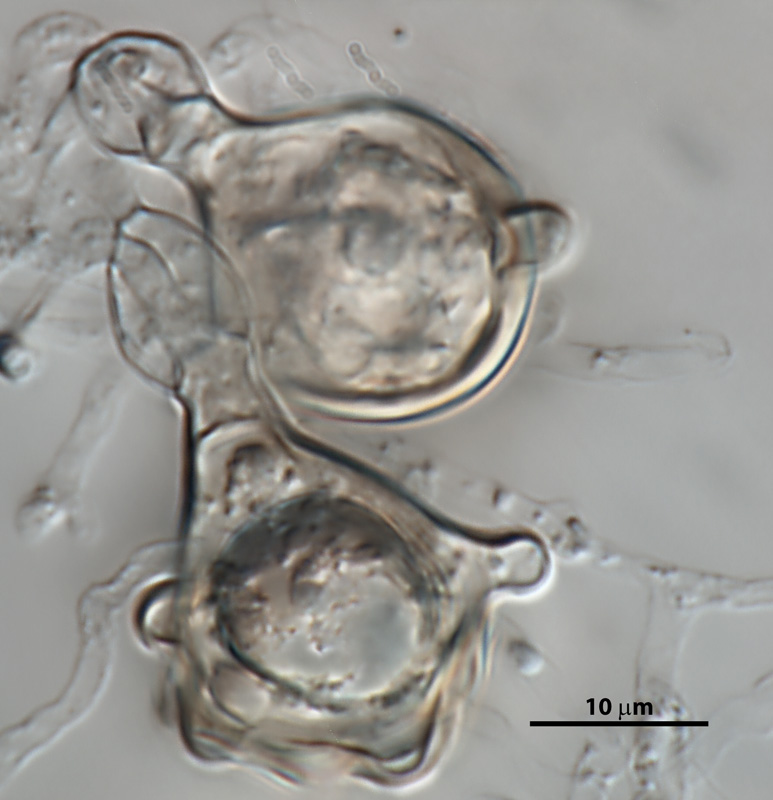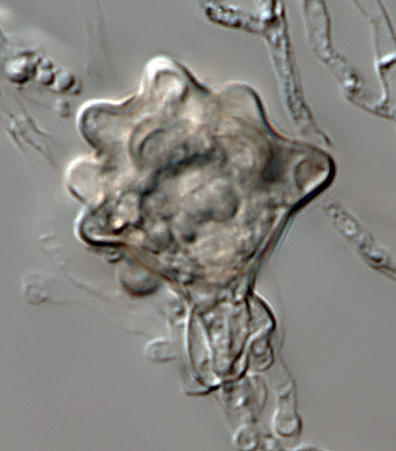Phytophthora castaneae
|
Phytophthora spp. in Clade 5: portion of the seven-loci ML phylogeny featuring the type cultures of 212 described species (by T. Bourret). Notice the position of P. castaneae Ex-type CBS 149821 = S&T BL 47G. Gloria Abad, USDA S&T.
|
|
Phytophthora spp. in Clade 5: Morphological Tabular key (PDF) and Tabular key legends (PDF) in IDphy2 KEY SECTION. Notice the data of P. castaneae Ex-type CBS 149821 = S&T BL 47G. Gloria Abad, USDA S&T.
|
|
Phytophthora castaneae (CPHST BL 47G) colony of the ex-type grown for 7 days on (a) V8 agar (b) potato dextrose agar (c) malt extract agar; photos by Krysta Jennings and Leandra Knight, USDA-APHIS-PPQ |
|
Phytophthora castaneae ex-type CPHST BL 47G asexual phase (a) and sexual phase (b-h): (b-h) oogonia with warty protuberances and distinct funnel-shaped bases and amphigynous antheridia; photos by V. Brewster, USDA-APHIS-PPQ. |
|
Coconut heart rot, resulting in a necrotic heart leaf, caused by Phytophthora castaneae; photo by Scot Nelson, University of Hawaii at Manoa |
|
Coconut heart rot, resulting in basal internal stem necrosis, caused by Phytophthora castaneae; photo by Scot Nelson, University of Hawaii at Manoa |
|
Phytophthora castaneae ex-type CPHST BL 47G asexual phase: persistent papillate sporangia and hyphal swellings; photo by V. Brewster, USDA-APHIS-PPQ. |
|
Phytophthora castaneae ex-type CPHST BL 47G sexual phase: oogonia with warty protuberances and distinct funnel-shaped bases and amphigynous antheridia; photo by V. Brewster, USDA-APHIS-PPQ. |
|
Phytophthora castaneae ex-type CPHST BL 47G sexual phase: oogonium with warty protuberances and distinct funnel-shaped base and amphigynous antheridium; photo by V. Brewster, USDA-APHIS-PPQ. |
|
Phytophthora castaneae ex-type CPHST BL 47G sexual phase: oogonia with warty protuberances and distinct funnel-shaped bases and amphigynous antheridia; photo by V. Brewster, USDA-APHIS-PPQ. |
|
Phytophthora castaneae ex-type CPHST BL 47G sexual phase: oogonia with warty protuberances and distinct funnel-shaped bases and amphigynous antheridia; photo by V. Brewster, USDA-APHIS-PPQ. |
|
Phytophthora castaneae ex-type CPHST BL 47G sexual phase: oogonium with warty protuberances and distinct funnel-shaped base and amphigynous antheridium; photo by V. Brewster, USDA-APHIS-PPQ. |
|
Phytophthora castaneae ex-type CPHST BL 47G sexual phase: oogonium with warty protuberances and distinct funnel-shaped base and amphigynous antheridium; photo by V. Brewster, USDA-APHIS-PPQ. |
Name and publication
Phytophthora castaneae Katsura & K. Uchida (1976)
Katsura K. 1976. Two new species of Phytophthora causing damping-off of cucumber and trunk rot of chestnut. Trans. Mycol. Soc. Japan 17: 238–242.
Nomenclature
Mycobank
Synonymy
≡ Phytophthora katsurae W.H. Ko & H.S. Chang, Mycologia 71: 841. 1979, nom. nov., nom. illegit. [superfluous]
NOTE: Phytophthora castaneae Katsura & K. Uchida (1976) is the correct legitimate name for the taxon causing trunk rot of Castanea crenata, and Phytophthora katsurae is an illegitimate superfluous name (Pennycook S.R. 2013).
Typification
from Katsura (1976)
Type: JAPAN, Ibaraki from chesnut (Castanea crenata Sieb. Et Zucc.) trunk rot, 1971, K. Uchida No 1971-031 (deposited to the Plant Pathology Herbarium, Kyoto Prefectural University, Japan)
Ex-type: Culture P8 = NBRC 9753 = ICMP 19434 = WPC P10187 (Weir et al., 2015, taxonomic revision of species in Cladeclade:
a taxonomic group of organisms classified together on the basis of homologous features traced to a common ancestor
5).
NOTES:
Deposit of culture into culture collection not indicated in original manuscript of Katsura 1976 [Weir et al (2015) published the taxonomic revision of species in Cladeclade:
a taxonomic group of organisms classified together on the basis of homologous features traced to a common ancestor
5].
Sequences published by Weir et al (2015). ICMP 19434 = ITS KP295319, COX1 KP295234, YPT1 KP295426, HSP90 KP295288, L10 KP295375, ENL KP295265, NADH1 KP295346, TIGA KP295404
Ex-type in other collections
(ET) CBS 149821, NRRL 64367, NBRC 9753, ICMP 19434, WPC P10187, K. Katsura, 1971-031, Kuri 4, K. Uchida P8, p45 (Gallegly), GAZ P990, S&T BL 47G (Abad), 22H6 (Hong)
Molecular identification
Voucher sequences for barcoding genes (ITS rDNA and COI) of the ex-type (see Molecular protocols page)
Phytophthora castaneae isolate CPHST BL 47G (=P10187 WPC) = ITS rDNA MG865470, COI MH136866
Voucher sequences for Molecular Toolbox with seven genes (ITS, β-tub, COI, EF1α, HSP90, L10, and YPT1
(see Molecular protocols page) (In Progress)
Voucher sequences for Metabarcoding High-throughput Sequencing (HTS) Technologies [Molecular Operational Taxonomic Unit (MOTU)]
(see Molecular protocols page) (In Progress)
Sequences with multiple genes for ex-type in other sources
- NCBI: Phytophthora castaneae CPHST BL 47G
- NCBI: Phytophthora castaneae P10187 (as P. katsurae)
- EPPO-Q-bank: Phytophthora castaneae
- BOLDSYSTEMS: Phytophthora castaneae PHYTO019-10 = P10187 as Phytophthora katsurae (barcoding COI & ITS)
Position in multigenic phylogeny with 7 genes (ITS, β-tub, COI, EF1α, HSP90, L10, and YPT1)
Clade 5
Morphological identification
Colonies and cardinal temperatures
Colony colony:
assemblage of hyphae which usually develops form a single source and grows in a coordinated way
morphology on V8-agar and MEA with slow growth and on PDA with non-distinct pattern. Minimum growth temperature 6°C; maximum 30°C, and optimum 22.3°C.
Conditions for growth and sporulation
Oogonia produced on V8A.
Asexual phase
SporangiaSporangia:
sac within which zoospores form, especially when water is cooled to about 10°C below ambient temperature; in solid substrates, sporangia usually germinate by germ tubes
papillatepapillate:
pertaining to the production of a distinct papilla at the distal end of the sporangium (cf. nonpapillate and semipapillate)
ocassionally bipapillate; persistentpersistent:
pertaining to sporangia that remain attached to the sporangiophore and do not separate or detach easily (cf. caducous)
; limoniform, ovoidovoid:
egg-shaped, with the widest part at the base of the sporangium and the narrow part at the apex
, obpyriformobpyriform:
inversely pear-shaped, i.e. with the widest part at the point of attachment (cf. pyriform)
to obturbinate, some asymmetric (10–43 µm long x 10–38 µm wide); originated mostly terminal but occasionally laterally attached and sometimes formed intercalarily in the sporangiophores. Hyphal swellings sometimes produced in the sporangiphore and close to sporangiumsporangium:
sac within which zoospores form, especially when water is cooled to about 10°C below ambient temperature; in solid substrates, sporangia usually germinate by germ tubes
. ChlamydosporesChlamydospores:
an asexual spore with a thickened inner wall that is delimited from the mycelium by a septum; may be terminal or intercalary, and survives for long periods in soil
spherical (12–19 µm in diam.).
Sexual phase
Homothallic. Oogonia have warty protuberances on the surface and a distinct funnel-shaped base (19–31 µm diam.); antheridiaantheridia:
the male gametangium; a multinucleate, swollen hyphal tip affixed firmly to the wall of the female gametangium (the oogonium)
amphigynousamphigynous:
pertaining to the sexual stage in which the antheridium completely surrounds the stalk of the oogonium (cf. paragynous)
and spherical to ovoidovoid:
egg-shaped, with the widest part at the base of the sporangium and the narrow part at the apex
; oosporesoospores:
zygote or thick-walled spore that forms within the oogonium after fertilization by the antheridium; may be long-lived
globoseglobose:
having a rounded form resembling that of a sphere
(15–27 µm diam.).
Most typical characters
Phytophthora castaneae is characterized by the presence of oogoniaoogonia:
the female gametangium in which the oospore forms after fertilization by the antheridium
with warty protuberances on the surface and a distinct funnel-shaped base.
Specimen(s) evaluated:
Phytophthora castaneae ex-type CPHST BL 47G duplicate of P10187, World Phytophthora Collection
Hosts and distribution
Distribution: Africa (Cote d'Ivoire), Asia (Japan, Taiwan), Caribbean (Jamaica), Pacific Islands (USA: HI), Papua New Guinea
Substrate: tree trunks, pods, fruit
Disease note: trunk rot of chestnut, fruit and heart rot of coconut
Hosts: Cocos nucifera (coconut, Arecaceae); Castanea crenata (chestnut, Fagaceae); also reported from Theobroma cacao (cacao, Malvaceae) (Erwin & Ribeiro 1996)
Retrieved January 29, 2018 from U.S. National Fungus Collections Nomenclature Database.
Quarantine status
USA: This species was listed as a species of concern during the 2009 Phytophthora prioritization project conducted by USDA APHIS PPQ CPHST PERAL (Schwartzburg et al.).
Additional references and links
Pennycook SR. 2013. Phytophthora castaneae, the correct name for P. katsurae nom. nov. superfl. Mycotaxon 121: 327-331.
Weir BS, Paredes EP, Anand N, Uchida JY, Shaun R, Pennycook SEB, and Beever RE. 2015. A taxonomic revision of Phytophthora Clade clade:
a taxonomic group of organisms classified together on the basis of homologous features traced to a common ancestor
5 including two new species, Phytophthora agathidicida and Phytophthora cocois. Phytotaxa 205: 021-038.
- SMML USDA-ARS: Phytophthora castaneae
- EPPO Global Database: Phytophthora castaneae
- Forest Phytophthoras of the world : Phytophthora castaneae
- CABI Digital Library: Phytophthora castaneae
- Encyclopedia of Life (EOL): Phytophthora castaneae
- Index Fungorum (IF): Phytophthora castaneae
- Index Fungorum (IF): Phytophthora katsurae Nom. illegit., Art.52.1
- Google All Phytophthora castaneae
- Google Images Phytophthora castaneae
- Google Scholar Phytophthora castaneae
- Google All Phytophthora katsurae (synonym)
- Google Images Phytophthora katsurae (synonym)
- Google Scholar Phytophthora katsurae (synonym)
Fact sheet author
Z. Gloria Abad, Ph.D., USDA-APHIS-PPQ-S&T Plant Pathogen Confirmatory Diagnostics Laboratory (PPCDL), United States of America.


